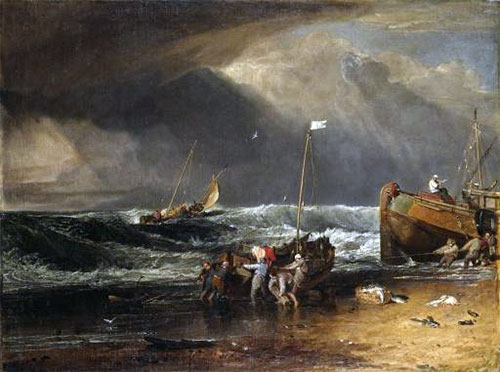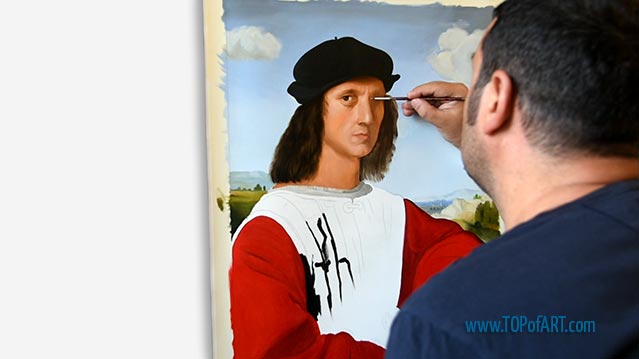A Coast Scene with Fishermen Hauling a Boat Ashore (The Iveagh Seapiece), c.1803/04 Joseph Mallord William Turner (1775-1851)
Location: Tate Gallery London United KingdomOriginal Size: 91.4 x 122 cm
Oil Painting Reproduction
If you want a different size than the offered
Description
Painted by European Аrtists with Academic Education
Museum Quality
+ 4 cm (1.6") Margins for Stretching
Creation Time: 8-9 Weeks
Creation Process
We create our paintings with museum quality and covering the highest academic standards. Once we get your order, it will be entirely hand-painted with oil on canvas. All the materials we use are the highest level, being totally artist graded painting materials and linen canvas.
We will add 1.6" (4 cm) additional blank canvas all over the painting for stretching.
High quality and detailing in every inch are time consuming. The reproduction of Joseph Mallord William Turner also needs time to dry in order to be completely ready for shipping, as this is crucial to not be damaged during transportation.
Based on the size, level of detail and complexity we need 8-9 weeks to complete the process.
In case the delivery date needs to be extended in time, or we are overloaded with requests, there will be an email sent to you sharing the new timelines of production and delivery.
TOPofART wants to remind you to keep patient, in order to get you the highest quality, being our mission to fulfill your expectations.
We not stretch and frame our oil paintings due to several reasons:
Painting reproduction is a high quality expensive product, which we cannot risk to damage by sending it being stretched.
Also, there are postal restrictions, regarding the size of the shipment.
Additionally, due to the dimensions of the stretched canvas, the shipment price may exceed the price of the product itself.
You can stretch and frame your painting in your local frame-shop.
Delivery
Once the painting A Coast Scene with Fishermen Hauling a Boat Ashore (The Iveagh Seapiece) is ready and dry, it will be shipped to your delivery address. The canvas will be rolled-up in a secure postal tube.
We offer free shipping as well as paid express transportation services.
After adding your artwork to the shopping cart, you will be able to check the delivery price using the Estimate Shipping and Tax tool.
Museum Quality
The paintings we create are only of museum quality. Our academy graduated artists will never allow a compromise in the quality and detail of the ordered painting. TOPofART do not work, and will never allow ourselves to work with low quality studios from the Far East. We are based in Europe, and quality is our highest priority.
Additional Information
Beyond the sky, the painting’s composition draws the viewer into a lively exchange between the figures on land and the tumult of the sea. On the far right, fishermen unite in a shared purpose, grappling with ropes as they haul their vessel from the foam. Their posture and collective strain contrast with the precariously angled boat in the rolling surf on the opposite side, which signals a more uncertain struggle. Diagonal lines of masts and ropes cut across the horizon, heightening the sense of movement and binding both sides of the painting together.
An essential part of the painting’s power lies in Turner’s brushwork. In the surging water, strokes are layered and spontaneous, capturing the sea’s constant shifting. Foam and cresting waves appear immediate, their forms modeled by swift movements of paint. Yet there is also a precise, almost reserved application where the figures, boats, and shoreline emerge with firm clarity, reminding us that this is still a finely observed scene rather than pure atmospheric experiment.
As for the subject itself, the painting depicts fishermen battling to secure their catch in the face of an unforgiving tide, while a second boat teeters off the crest of a wave. It is a drama of everyday toil, anchored by the powerful theme of man versus nature. The eye is led smoothly from the shoreline’s gritty details to the billowing skies above, absorbing the human element in a grander, elemental spectacle.
A glance at the broader context reveals how this piece converses with maritime traditions set by 17th-century Dutch painters, whose works also feature in collections associated with this painting’s provenance. Turner’s display of swirling clouds and agitated sea reveals his interest in extending that Northern European aesthetic into a more emotional realm. The choice of this canvas for a bequest testifies to the ongoing fascination with seascapes, particularly among collectors enamored of sailing, and to Turner’s success in bridging rigorous observation with romantic expression.
1 Reviews
5.00 Overall rating
The Society of Painters in Water-Colors (later the Old Water-Color Society) was founded in 1802, and Turner was a prime force behind its establishment although he never became a member. The aim was to show watercolor as a medium equal to oil in the historical genre, to combine figures and grandiose landscape in heroic style. Girtin and Turner, traditionally considered the fathers of British watercolor, were firmly rooted in the importance of observation. Turner's Study of Fish: Two Tench, a Trout and a Perch (1822) and Head of a Heron (1815) are watercolor studies of natural phenomena - the pattern and reflection of the types of fish, the plumage on the bird's head. Observation of such realistic detail would be seen again in paintings of High Victorian realism and in the minutiae of Pre-Raphaelitism. During the 1820s and 1830s, Turner illustrated a number of topographical books. The most ambitious, Picturesque Views in England and Wales, was not a financial success: travel on the Continent was again possible, and whilst the eighteenth-century traveler had visited the classical sites, the nineteenth-century middle-class tourist was more interested in novelty and exoticism.
In oil, as in watercolor, Turner explored mythological, biblical, historical and marine painting, while developing a theory of color association and an examination of light that would fascinate the Impressionists. The origins of his most famous early history piece, Snow Storm: Hannibal and His Army Crossing the Alps (1812), and his shipwrecks lay in Burke's theory of the sublime, which gave precedence over ideal beauty to pictorial effects that produced the strongest emotion. At the same time, Turner was painting British landscape in Ideal form, for example Richmond Hill on the Prince Regent's Birthday (1819).This search for subliminal naturalism lies behind much of his work, whether in the swirling waves of his 'shock' oil paintings of shipwrecks and sea storms or in the study of light and pure color in his watercolors.
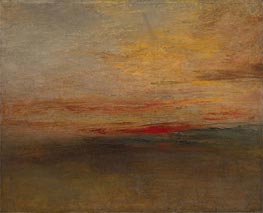
Sunset c.1830/35
$806
$49.28
Joseph Mallord William Turner
Original Size:66.7 x 82 cm
Tate Gallery, London, United Kingdom
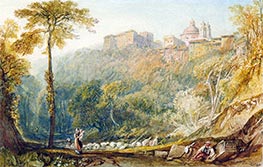
View of La Riccia (Ariccia) 1817
$47.03
Joseph Mallord William Turner
Original Size:13.6 x 21.5 cm
The Clark Art Institute, Massachusetts, USA
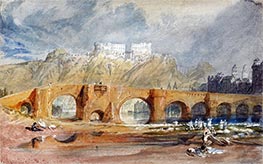
The Moselle Bridge at Coblenz 1817
$47.03
Joseph Mallord William Turner
Original Size:20 x 31.4 cm
The Clark Art Institute, Massachusetts, USA
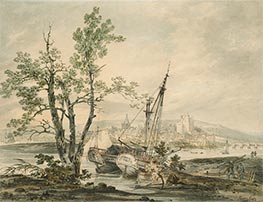
Rochester c.1793
$47.03
Joseph Mallord William Turner
Original Size:21.6 x 28 cm
The Clark Art Institute, Massachusetts, USA
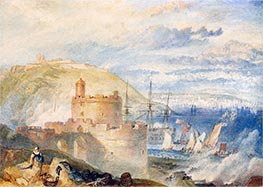
Falmouth Harbor c.1825
$47.03
Joseph Mallord William Turner
Original Size:16 x 22 cm
The Clark Art Institute, Massachusetts, USA
